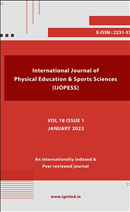Analysis of typical injuries among Male Basketball Players of West Zone Inter-University
Main Article Content
Authors
Abstract
Basketball, a dynamic team sport known for its fast-paced nature, has become widely popular, captivating players and spectators alike. This research explores the prevalence of injuries among male basketball players in the West Zone Inter-University competition. The sport's unique demands, including high-speed ball movement, agility, and teamwork, make it essential to understand and address injuries, particularly those related to the vulnerable bony growth plates in young athletes. The study, conducted through a survey methodology, involved a carefully designed questionnaire administered by a knowledgeable researcher. The findings reveal that 100 of West Zone Inter-University basketball players experienced injuries during their playing careers. Notably, 10 of these injuries were attributed to opponents. Analysis of the injured body parts indicates that ankles (25) were the most commonly affected, followed by wrists (18), and shouldersknees (15). This insight provides valuable information for healthcare professionals, coaches, and athletes in developing strategies to prevent and manage injuries in the context of university-level basketball competitions. Understanding the specific injury patterns can contribute to more effective injury prevention and treatment protocols, ensuring the long-term health and performance of basketball players.
Downloads
Download data is not yet available.
Article Details
Section
Articles
References
- Meenu, I. M. Comparative Study of Emotional Intelligence Among Female Team Game Players of Hariyana, International Journal of Physical Education, Sports and Health, Vol. 2 (1). (2015)
- Mouasi, H. S., Yarmohammadi, S., Nosrat, B. A., Tarasi, Z. The Relationship between Emotional Intelligence and Job Satisfaction of Physical Education Teachers, Annals of Biological Research, Vol. 3(2). (2012)
- Dhananjay, B. V. A comparative Study of Emotional Intelligence Between Rural and Urban Basketball Players, International Journal of Physical Education , Sports and Health, Vol. 3(2). (2016)
- Petrides, K. V., Pita, R., & Kokkinaki, F. (2007) The Location of Trait Emotional Intelligence in Personality Factor Space, British Journal of Psychology, 98, 273-289. https://www.doi.org.
- 5. Petrides, K. V. (2011). An Application of be life-importance theory with reference to trait Emotional Intelligence, Mood and Somatic Complaints, Scandinavian Journal of Psychology, 52, https://onlinelibrary.wiley.com.
- Singaravelu S. (2007). Emotional Intelligence of student teachers (preservice) at primary level in Puducherry region. M.Ed. Dissertation, www.ijariie.com.

